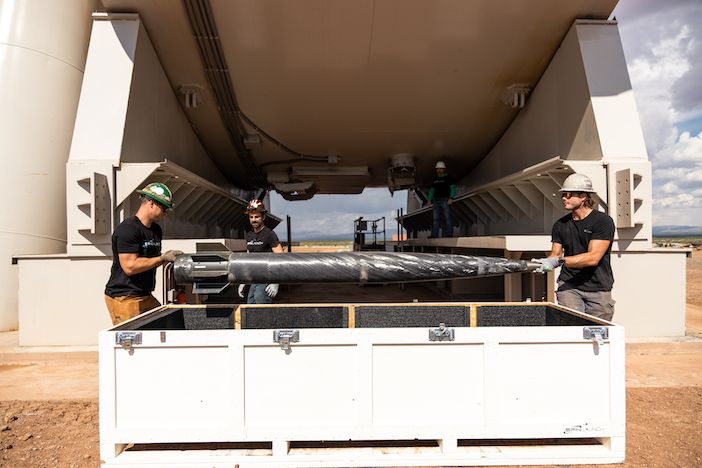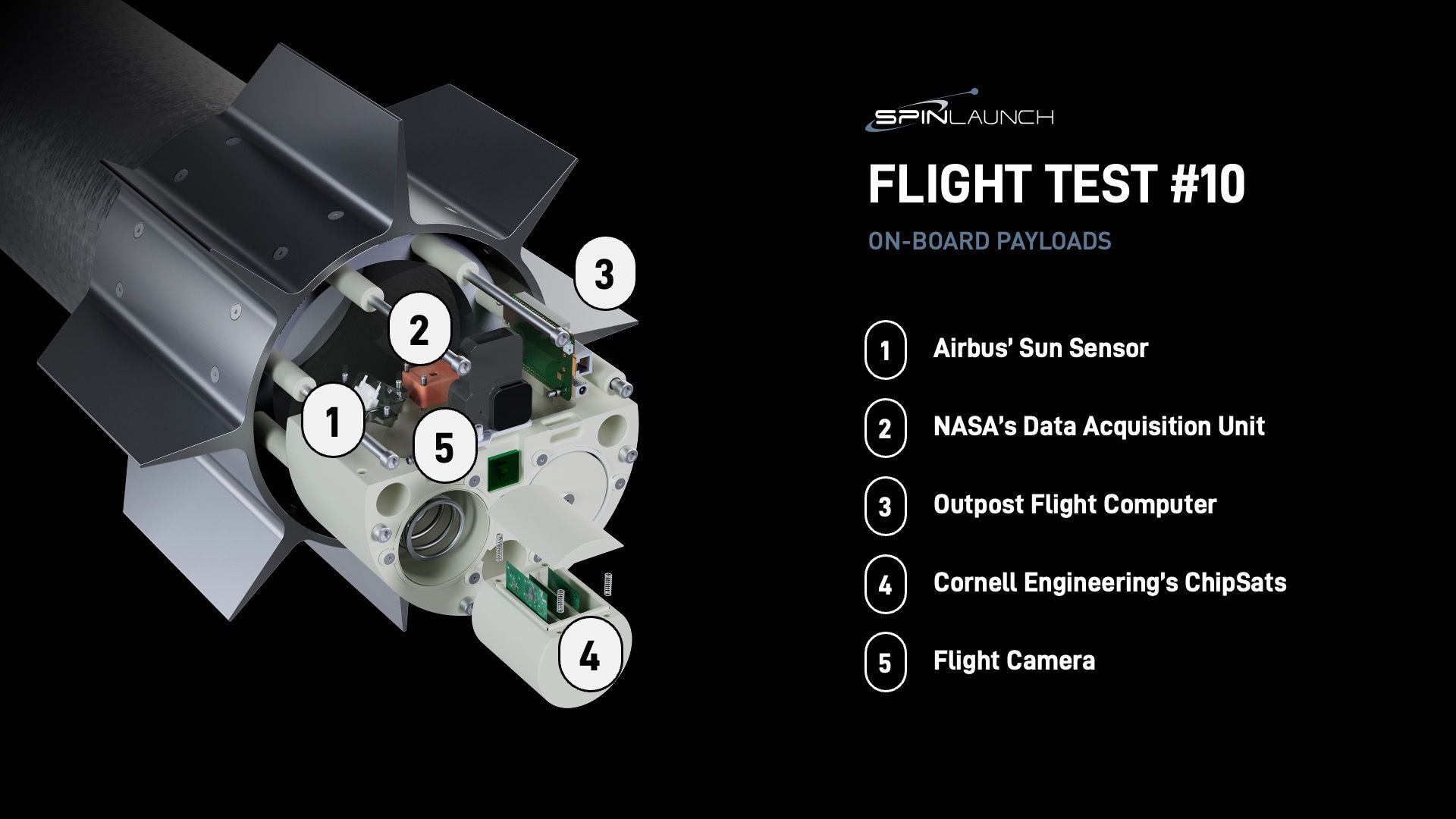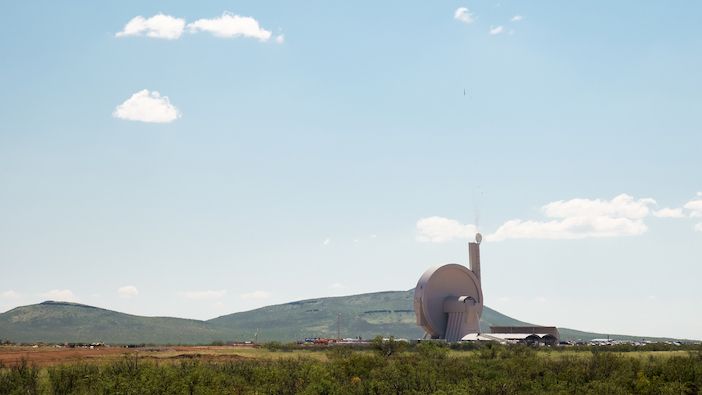Suborbital accelerator developer SpinLaunch ran a successful tenth flight test from Spaceport America, New Mexico last month which carried payloads including standard satellite parts from partner companies.
The flight test is seen as key milestone by the company towards commercialization because the payloads were provided by external partners NASA, Airbus US, Cornell University and satellite firm Outpost for the first time.
SpinLaunch, which was founded in 2014 is developing a launch system that uses a carbon fiber rotating arm within a massive circular vacuum chamber to spin payloads to incredibly fast speeds and fling them up through the atmosphere. Once above the stratosphere, a rocket provides the final velocity necessary for orbital insertion and positioning.
SpinLaunch said that Flight Test 10 demonstrated that SpinLaunch partners’ standard satellite components are compatible with the company’s unusual approach to space launches and provided critical flight data. All payloads were flown and recovered successfully.
The flight test had a similar flight trajectory as previous campaigns and was witnessed by an audience of 150 partners and government officials.
The company has conducted 10 flight tests in just under eleven months since the Suborbital Mass Accelerator came online in November 2021.
SpinLaunch broke ground on its facility at Spaceport America in 2019. The 150ft (45m) tower constructed at Spaceport America is the world’s tallest suborbital accelerator and has cost around US$38 million to build.

Jonathan Yaney, founder and CEO of SpinLaunch said, “Flight Test 10 represents a key inflection point for SpinLaunch, as we’ve opened the Suborbital Accelerator system externally for our customers, strategic partners, and research groups.
“The data and insights collected from flight tests will be invaluable for both SpinLaunch, as we further the development of the Orbital Launch system, and for our customers who are looking to us to provide them with low-cost, high-cadence, sustainable access to space.”
Four partner payloads and two instrumentation payloads were flown on the Suborbital Accelerator flight test vehicle.
As part of the pre-flight qualification process, SpinLaunch accelerated payloads up to 10,000G in SpinLaunch’s 12m (40ft) Lab Accelerator at its Long Beach, California headquarters. Payloads were inspected post-spin and subsequently integrated into the Flight Test Vehicle in preparation for Flight Test 10.
Flight Test 10 Payloads
Earlier this year, SpinLaunch signed a Space Act Agreement with NASA to develop, integrate and fly a NASA payload, providing the agency with the information necessary to determine the potential of future commercial launch opportunities with SpinLaunch.
After the completion of Flight Test 10, the DAQ was successfully recovered and removed from the Flight Test Vehicle. SpinLaunch test engineers retrieved the data and reviewed it with NASA personnel from their Flight Opportunities program, who were onsite to observe the flight test in person.

For Flight Test 10, Airbus US provided its satellite sun sensor, which is typically used for spacecraft attitude control and positioning purposes. The sun sensor was tested at 10,000G in the Lab Accelerator before it was integrated with the flight test vehicle.
Following both the high-g centrifuge pre-launch testing and Flight Test 10, the sun sensor’s output signal was compared to the preflight data. This comparison verified that the performance and operation of the sun sensor was not affected by the loads during the pre-flight, flight, or recovery phases.
SpinLaunch and Airbus US plan to work together to qualify a variety of Airbus U.S. satellite systems that are compatible with the SpinLaunch orbital centrifuge and flight environment.
“Our Airbus US engineering team is excited to work with SpinLaunch in support of this significant advancement of a new accelerated launch concept,” said Airbus US chief technology officer Armen Askijian. “We look forward to continued collaboration and future success.”
Cornell Engineering’s Space Systems Design Studio (SSDS) used Flight Test 10 to deploy a collection of its small, inexpensive ChipSat satellites, which are designed to provide distributed in-situ measurements of the upper atmosphere. The flight test exercised the operation of a SpinLaunch designed payload deployment system.
Future SpinLaunch tests with SSDS may include high altitude ChipSat dispersion to verify the accuracy of SSDS’s ChipSat reentry and atmospheric trajectory simulations.
Outpost is developing reusable satellites for high-precision Earth return and provided SpinLaunch with an onboard computer for testing and qualification in the SpinLaunch launch environment.
After a successful flight and recovery of the payload, a final functional test was performed, validating the flight computer is compatible with SpinLaunch’s launch environment. SpinLaunch and Outpost plan to continue their ongoing collaboration as both organizations seek to provide lower cost, more sustainable access to space.





